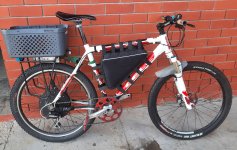I'm running 9c 7x9 motor, 45A green time controller on a hardtail with 26" wheels. I do use regen and have been riding this setup for about 2 years. I want to go up to 50km/h and mostly ride streets with some hills. I'm interested in range and battery longevity over speed/torque.
My current battery is a 14s8p pack (salvaged, with no-brand BMS), in series with a smaller 2s10p pack with 2500mAh cells salvaged from a scooter and no bms. I bulk charge the 16s series string outdoors up to about 62.5V and hope for the best. I avoid going anywhere close to 4.2V/cell. I have bypassed BMS on on the larger pack for discharge, and only use the BMS for charging. None of this is best practice and I want to improve.
I'm generally happy with the performance, but have noticed its getting sluggish and range is lower than it used to be. The pack voltage measured at the controller is sagging from 62V down to about 54.5V when going up a steep hill. I'm not measuring battery current but assume its around 45A (no shunt mod). Is this bad for Sag?
I'm looking to build a pack with Queen Battery 18650 2500mAh "12A" cells and Smart BMS. Has anyone had direct experience with this cell? I am particularly interested in longevity/cycle life.
QB18650 2500mAh
I want to limit the weight of battery <150 Cells so I can still lift the bike over fences and into car. I cannot decide between 16s9p and 17s8p. My current 16s battery leaves me wanting more speed, but is sagging so badly I'm not sure if thats the issue. I think regen is quite stressful on the cells due to lower rated charge rate, would the 9p config have greater longevity when using regeneration? Will a new 8p battery perform so much better that 9p is overkill?
Smart BMS
The main reason for building a new battery is I feel my existing one is unsafe, particularly for charging. I want a smart BMS to improve safety.
Others have recommended Heltec, Tucc and JBD smart BMS. I am leaning toward JBD as they seem to allow up to 17s on their 80A models. Again, I'm interested to hear peoples experience with this BMS. I cannot tell from the advertisement if NTC temperature probe and balance wires are included, and the seller is unresponsive. Also unsure if I need to purchase any additional module to allow bluetooth connectivity to change basic BMS parameters (UART/CAN). I think the Ad says Bluetooth included, but UART/CAN is not. Does anyone know?
JBD BMS link
I have a MOT spot welder, and have plenty of dead cells to practice on. planning on using copper sandwich using 0.1mm copper strip and nickel plated steel strip on top. I'll use cell holders, and insulating washers.
My current battery is a 14s8p pack (salvaged, with no-brand BMS), in series with a smaller 2s10p pack with 2500mAh cells salvaged from a scooter and no bms. I bulk charge the 16s series string outdoors up to about 62.5V and hope for the best. I avoid going anywhere close to 4.2V/cell. I have bypassed BMS on on the larger pack for discharge, and only use the BMS for charging. None of this is best practice and I want to improve.
I'm generally happy with the performance, but have noticed its getting sluggish and range is lower than it used to be. The pack voltage measured at the controller is sagging from 62V down to about 54.5V when going up a steep hill. I'm not measuring battery current but assume its around 45A (no shunt mod). Is this bad for Sag?
I'm looking to build a pack with Queen Battery 18650 2500mAh "12A" cells and Smart BMS. Has anyone had direct experience with this cell? I am particularly interested in longevity/cycle life.
QB18650 2500mAh
I want to limit the weight of battery <150 Cells so I can still lift the bike over fences and into car. I cannot decide between 16s9p and 17s8p. My current 16s battery leaves me wanting more speed, but is sagging so badly I'm not sure if thats the issue. I think regen is quite stressful on the cells due to lower rated charge rate, would the 9p config have greater longevity when using regeneration? Will a new 8p battery perform so much better that 9p is overkill?
Smart BMS
The main reason for building a new battery is I feel my existing one is unsafe, particularly for charging. I want a smart BMS to improve safety.
Others have recommended Heltec, Tucc and JBD smart BMS. I am leaning toward JBD as they seem to allow up to 17s on their 80A models. Again, I'm interested to hear peoples experience with this BMS. I cannot tell from the advertisement if NTC temperature probe and balance wires are included, and the seller is unresponsive. Also unsure if I need to purchase any additional module to allow bluetooth connectivity to change basic BMS parameters (UART/CAN). I think the Ad says Bluetooth included, but UART/CAN is not. Does anyone know?
JBD BMS link
I have a MOT spot welder, and have plenty of dead cells to practice on. planning on using copper sandwich using 0.1mm copper strip and nickel plated steel strip on top. I'll use cell holders, and insulating washers.


